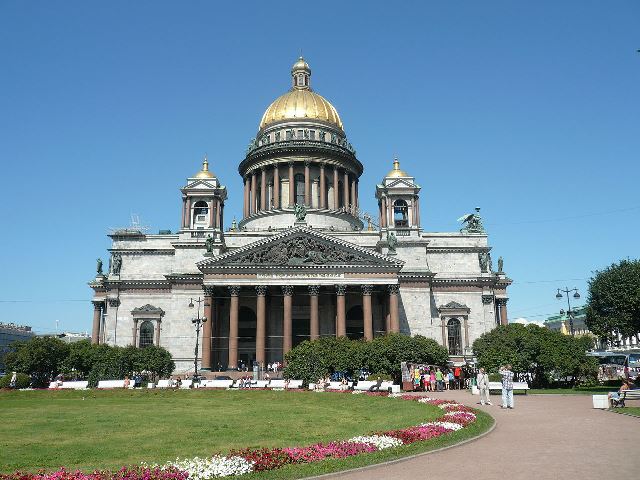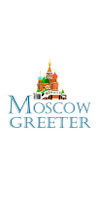
Saint Isaac’s Cathedral
Address: Isaakievskaya Square, 1
Website:http://eng.cathedral.ru/ (Russian only)
Phone: +7 (812) 315-97-32.
How to get there:
The nearest metro station is Sadovaya. When you exit its hall, you’ll find yourself in an underground walkway. Go to your right. At the end of the corridor, you will see two exits. Use the one you like - the necessary street, Grivtsova Lane, is right between them.
Go along Grivtsova Lane, cross the Demidov Bridge over the Griboedov Canal, and keep going until you reach the Moyka River (it will be the second water flow on your way), then turn to your left. Soon you will see the Siny Bridge. Cross it, go forward and in about two minutes you will arrive at Isaakievskaya Square, right in front of the Cathedral.
Opening hours:
The museum is closed on Wednesdays.
16 September – 30 April: 11 am – 7 pm.
1 May – 15 September: 10 am – 7 pm.
Ticket office closes at 6 pm.
Also, 1 May - 1 October: evening excursions, 6:30 pm –10:30 pm.
The colonnade
The colonnade is closed every second Wednesday of the month.
16 September – 30 April: 11 am – 5 pm.
1 May – 15 September: 10 am – 5 pm.
Also, 1 May – 1 November: evening excursions, 6 am – 11 pm.
http://www.cathedral.ru/raspisanie
Tickets/entrance fee:
Full entrance fee – 320 RUB; students – 170 RUB.
Entrance fee to the Colonnade – 100 RUB (excursion included).
St. Isaac’s Cathedral, built by the famous architect Auguste de Monferrand, is the fourth-largest cathedral in the world. It is 100.5 meters high and can be seen from almost every part of St. Petersburg. Meanwhile, the colonnade along the perimeter of the cathedral’s dome commands a unique view on the entire city, from the center to the outskirts. There are many legends about the cathedral, but its real story is no less interesting.
Overview:
With a floor space of 4000 square meters, the cathedral can easily accommodate some 1200 people. These numbers are impressive even without seeing the temple’s interior – the cathedral owns a unique collection of 19th century Russian monumental paintings and sculptures, including more then 300 hundred sculptures, bas-reliefs and mosaics. It is sometimes called the unofficial museum of ornamental stones. The altar contains one of the largest glass paintings in Russia.
Nowadays the cathedral still serves as a museum, though the contemporary exposition has nothing to do with the “science of atheism” – it is dedicated to the history of the temple itself. Since 1990, church services are held in the cathedral, but only on Christian holidays. And sometimes church music concerts take place within the temple’s walls.
The cathedral’s dome drum is decorated with 72 monolithic granite columns, each of which weighs between 64 and 114 tons. It was the first time in the history of Russian architecture that columns this heavy were established this high - the colonnade is 43 meters above the ground.
The main dome of the cathedral is the third metal dome to be created in the world. It took 100 kilograms of gold to gild it. The method for the gilding included the use of mercury and sixty masters died from mercury poisoning during the process.
The main dome is surrounded by four small bell-towers, topped by small domes. It gives the cathedral a slight resemblance to a 19th century object of daily use – an inkpot. Of course, residents noticed this resemblance and the cathedral received the relevant nickname.
It took an incredibly long time to erect the cathedral. Alexander I did not live to see the work finished – he died in 1825. For Nicholas I, who inherited the throne, the construction was very important. He even refused to build a new port in the city to save the money for the cathedral.
There was a legend saying that a fortuneteller predicted Monferrand would die right after the construction was finished, which is why the architect did not hurry but took the time to design and to realize other projects such as the Aleksandrovskaya Column, the Monument to Nicholas I and several mansions while still working on the cathedral’s construction. The real reason for the delay, however, was that there were some serious mistakes in the drafts, which were found and, to the extent possible, corrected only after the works had already begun. However, Monferrand did die only a month after the consecration of the cathedral and the cause of his death remains unknown. He wanted to be buried within the cathedral walls, but Alexander did not carry out his wish – Monferrand’s body was sent back to his motherland, France.
The temple was consecrated on 30 May 1858, on Saint Isaac’s Day, and became the main cathedral of the Russian Empire. Even after the consecration, the cathedral remained covered with scaffolding for a very long time – apparently, some works were not finished.
A city legend, which appeared in those days, said that when the scaffolding would be removed, the Romanov Dynasty would be over. Believe it or not, the scaffolding was taken down in 1916, not long before Nicholas II’s abdication.
Useful tips:
-
There is a souvenir shop inside the cathedral.
-
If you want to see the city from the colonnade, remember there is no lift, only a very narrow and very long staircase.



